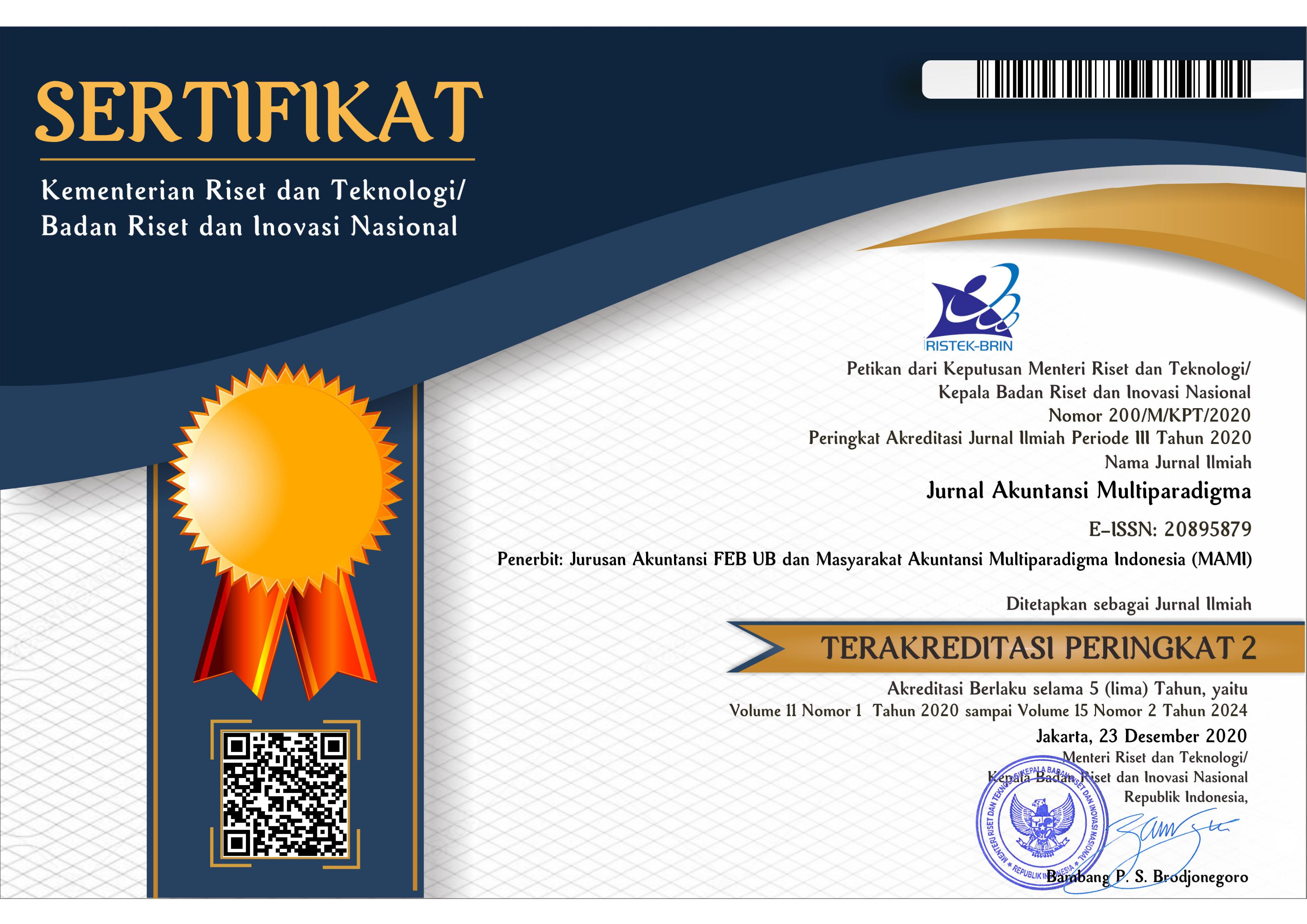PERILAKU PENGGUNA SISTEM INFORMASI AKUNTANSI E-COMMERCE
Abstract
Abstrak: Perilaku Pengguna Sistem Informasi Akuntansi E-Commerce. Tujuan penelitian ini dilakukan untuk menelusuri perilaku seseorang menggunakan pencatatan akuntansi keuangan berbasis teknologi informasi di e-commerce. Analisis data yang digunakan untuk menyelesaikan penelitian ini adalah structural equation modeling- partial least square (SEM-PLS) dengan total sampel adalah 100 responden penjual dan pembeli di beberapa e-commerce. Penelitian ini memiliki hasil bahwa e-commerce diminati oleh pengguna. Sistem ini memiliki sejumlah kemudahan di mata pengguna. Oleh karena itu, perusahaan e-commerce diharapkan mendapatkan masukan mengenai kecenderungan perilaku pelanggan dalam menggunakan pencatatan akuntansi keuangan berbasis teknologi informasi.
Abstract: The Behaviour of E-Commerce Accounting Information System Users. The purpose of this study is conducted to determine a person's behavior using information technology-based financial accounting records in e-commerce. Analysis of the data used to complete this research is structural equation modeling - partial least square (SEM-PLS) with a total sample of 100 respondents of sellers and buyers in several e-commerce sites. This study has the result that e-commerce is in demand by users. This system has several conveniences in the user's eyes. Therefore, e-commerce companies are expected to get input regarding customer behavior trends in using information technology-based financial accounting records.
Keywords
Full Text:
PDFReferences
Abdullah, A, Thomas, B, Murphy, L, & Plant, E. (2018). An Investigation of the Benefits and Barriers of E-Business Adoption Activities in Yemeni SME. Strategic Change, 27(3), 195-208. https://doi.org/10.1002/jsc.2195.
Abebe, M. (2014). Electronic Commerce Adoption, Entrepreneurial Orientation and Small and Medium-Sized Enterprise (SME) Performance. Journal of Small Business and Enterprise Development, 21(1), 100-116. https://doi.org/10.1108/JSBED-10-2013-0145
Abrahão, R. D. S., Moriguchi, S. N., & Andrade, D. F. (2016). Intention of Adoption of Mobile Payment: An Analysis in the Light of the Unified Theory of Acceptance and Use of Technology (UTAUT). RAI Revista de Administração e Inovação, 13(3), 221–230. https://doi.org/10.1016/j.rai.2016.06.003
Al-Bakri, A., & Katsioloudes, M. (2015). The Factors Affecting E-Commerce Adoption by Jordanian SMEs. Management Research Review, 38(7), 726-749. https://doi.org/10.1108/MRR-12-2013-0291
Alkhatib, E., Ojala, H., & Collis, J. (2019). Determinants of the Voluntary Adoption of Digital Reporting by Small Private Companies to Companies House: Evidence from the UK. International Journal of Accounting Information Systems, 34, 1-16. https://doi.org/10.1016/j.accinf.2019.06.004
Ayuningtiyas, G., & Harris, L. (2011). Structural Assurance, Kepercayaan pada Sistem E-Commerce, dan Niat Bertransaksi Secara Online. Jurnal Akuntansi Multiparadigma, 2(2), 342-368. https://doi.org/10.18202/jamal.2011.08.7125
Barkatullah, A. H., & Djumadi. (2018). Does Self-Regulation Provide Legal Protection and Security to E-Commerce Consumers? Electronic Commerce Research and Applications, 30, 94-101. https://doi.org/10.1016/j.elerap.2018.05.008
Bhatia, L., & Jain, B. (2013). Card Bases Payment Mode – An Accounting Perspective: A Comparison between Credit Card and Debit Card Payment Systems in India. International Journal of Managerial and Financial Accounting, 5(1), 33-44. https://doi.org/10.1504/IJMFA.2013.052408
Boonsiritomachai, W., & Pitchayadejanant, K. (2018). Determinants Affecting Mobile Banking Adoption by Generation Y based on the Unified Theory of Acceptance and Use of Technology Model modified by the Technology Acceptance Model Concept. Kasetsart Journal of Social Sciences, 40(2), 349-358. https://doi.org/10.1016/j.kjss.2017.10.005
Boritz, J. E., & No, W. G. (2011). E-Commerce and Privacy: Exploring What We Know and Opportunities for Future Discovery. Journal of Information Systems, 25(2), 11-45. https://doi.org/10.2308/isys-10090
Chi, T. (2018). Understanding Chinese Consumer Adoption of Apparel Mobile Commerce: An Extended TAM Approach. Journal of Retailing and Consumer Services, 44, 274-284. https://doi.org/10.1016/j.jretconser.2018.07.019
Chiu, T., & Wang, T. D. (2019). The COSO Framework in Emerging Technology Environments: An Effective in-Class Exercise on Internal Control. Journal of Emerging Technologies in Accounting, 16(2), 89-98. https://doi.org/10.2308/jeta-52500
Dagiliene, L., & Šutiene, K. (2019). Corporate Sustainability Accounting Information Systems: A Contingency-Based Approach. Sustainability Accounting, Management and Policy Journal, 10(2), 260-289. https://doi.org/10.1108/SAMPJ-07-2018-0200
Fan, J., Tang, L., Zhu, W., & Zou, B. (2018). The Alibaba Effect: Spatial Consumption Inequality and the Welfare Gains from E-Commerce. Journal of International Economics, 114, 203-220. https://doi.org/10.1016/j.jinteco.2018.07.002
Fang, Y., Lim, K. H., Qian, Y., & Feng, B. (2018). System Dynamics Modeling for Information Systems Research: Theory Development and Practical Application. MIS Quarterly: Management Information Systems, 42(4), 1303-1329. https://doi.org/10.25300/MISQ/2018/12749
Fleischman, G., Walker, K., & Johnson, E. (2010). A Field Study of User Versus Provider Perceptions of Management Accounting System Services. International Journal of Accounting & Information Management, 18(3), 252-285. https://doi.org/10.1108/18347641011068992
Gonzalez,G. C., Sharma, P. N., & Galletta, D. (2012). Factors Influencing the Planned Adoption of Continuous Monitoring Technology. Journal of Information Systems, 26(2), 53-69. https://doi.org/10.2308/isys-50259
Gullberg, C. (2016). What Makes Accounting Information Timely? Qualitative Research in Accounting & Management, 13(2), 189-215. https://doi.org/10.1108/QRAM-03-2014-0019
Hardanti, K. N., Subekti, I., & Mardiati, E. (2014). Determinan Minat Keperilakuan dan Perilaku Menggunakan Sistem Enterprise Resource Planning. Jurnal Akuntansi Multiparadigma, 5(1), 29-40. https://doi.org/10.18202/jamal.2014.04.5003
Hair, J. F., Ringle, C. M., & Sarstedt, M. (2011). PLS-SEM: Indeed a Silver Bullet. Journal of Marketing Theory and Practice, 19(2), 139-152. https://doi.org/10.2753/MTP1069-6679190202
Hariyati, H., Tjahjadi, B., & Soewarno, N. (2019). The Mediating Effect of Intellectual Capital, Management Accounting Information Systems, Internal Process Performance, and Customer Performance. International Journal of Productivity and Performance Management, 68(7), 1250-1271. https://doi.org/10.1108/IJPPM-02-2018-0049
Hino, H. (2015). Assessing Factors Affecting Consumers' Intention to Adopt Biometric Authentication Technology in E-shopping. Journal of Internet Commerce, 14(1), 1-20. https://doi.org/10.1080/15332861.2015.1006517
Hormati, A. (2012). Pengujian Model Unified Theory of Acceptance and Use of Technology dalam Pemanfaatan Sistem Informasi Keuangan Daerah. Jurnal Akuntansi Multiparadigma, 3(1), 1-24. https://doi.org/10.18202/jamal.2012.04.7140
Jahanshahi, A., Zhang, S., & Brem, A. (2013). E-Commerce for SMEs: Empirical Insights from Three Countries. Journal of Small Business and Enterprise Development, 20(4), 849-865. https://doi.org/10.1108/JSBED-03-2012-0039
Li, C. Y., & Ku, Y. C. (2018). The Power of a Thumbs-Up: Will E-Commerce Switch to Social Commerce? Information & Management, 55(3), 340-357. https://doi.org/10.1016/j.im.2017.09.001
Meiranto, W. (2011). Kajian Online Sistem Informasi BRI (Brinets): Pendekatan Technology Acceptance Model (TAM). Jurnal Akuntansi Multiparadigma, 2(1), 91-103. https://doi.org/10.18202/jamal.2011.04.7112
Mhina, J. R. A., Johar, M. G. M., & Alkawaz, M. H. (2019). The Influence of Perceived Confidentiality Risks and Attitude on Tanzania Government Employees’ Intention to Adopt Web 2.0 and Social Media for Work-Related Purposes. International Journal of Public Administration, 42(7), 558-571. https://doi.org/10.1080/01900692.2018.1491596
Moghavvemi, S., & Salleh, N. A. M. (2014). Effect of Precipitating Events on Information System Adoption and Use Behaviour. Journal of Enterprise Information Management, 27(5), 599-622. https://doi.org/10.1108/JEIM-11-2012-0079
Nguyen, D. H., Leeuw, S. D., Dullaert, W., & Foubert, B. P. J. (2019). What is the Right Delivery Option for You? Consumer Preferences for Delivery Attributes in Online Retailing. Journal of Business Logistics, 40(4), 299-321. https://doi.org/10.1111/jbl.12210
Nunkoo, R., Ramkissoon, H., & Gursoy, D. (2013). Use of Structural Equation Modeling in Tourism Research: Past, Present, and Future. Journal of Travel Research, 52(6), 759–771. https://doi.org/10.1177/0047287513478503
Okundaye, K., Fan, S., & Dwyer, R. (2019). Impact of Information and Communication Technology in Nigerian Small-to Medium-Sized Enterprises. Journal of Economics, Finance and Administrative Science, 24(47), 29-46. https://doi.org/10.1108/JEFAS-08-2018-0086
Raza, S. A., Shah, N., & Ali, M. (2019). Acceptance of Mobile Banking in Islamic Banks: Evidence from Modified UTAUT Model. Journal of Islamic Marketing, 10(1), 357–376. https://doi.org/10.1108/JIMA-04-2017-0038
Rodrigues, G., Sarabdeen, J., & Balasubramanian, S. (2016). Factors that Influence Consumer Adoption of E-government Services in the UAE: A UTAUT Model Perspective. Journal of Internet Commerce, 15(1), 18-39. https://doi.org/10.1080/15332861.2015.1121460
Sharma, H., & Aggarwal, A. G. (2019). Finding Determinants of E-Commerce Success: A PLS-SEM Approach. Journal of Advances in Management Research, 16(4), 453-471. https://doi.org/10.1108/JAMR-08-2018-0074
Shemi, A., & Procter, C. (2018). E-Commerce and Entrepreneurship in SMEs: Case of MyBot. Journal of Small Business and Enterprise Development, 25(3), 501-520. https://doi.org/10.1108/JSBED-03-2017-0088
Talukder, M., Quazi, A., & Sathye, M. (2014). Mobile Phone Banking Usage Behaviour: An Australian Perspective. Australasian Accounting, Business and Finance Journal, 8(4), 83-104. https://doi.org/10.14453/aabfj.v8i4.6
Trojanowski, M., & Kułak, J. (2017). The Impact of Moderators and Trust on Consumer’s Intention to Use a Mobile Phone for Purchases. Journal of Management and Business Administration. Central Europe, 25(2), 91–116. https://doi.org/10.7206/jmba.ce.2450-7814.197
Varma, A. (2018). Mobile Banking Choices of Entrepreneurs: A Unified Theory of Acceptance and Use of Technology (UTAUT) Perspective. Theoretical Economics Letters, 08(14), 2921–2937. https://doi.org/10.4236/tel.2018.814183
Venkatesh, V., Thong, J. Y. L., & Xu, X. (2016). Unified Theory of Acceptance and Use of Technology: A Synthesis and the Road Ahead. Journal of the Association of Information Systems, 17(5), 328–376. https://doi.org/10.17705/1jais.00428
Xu, W., Zuo, Y., Gao, X., & Yao, M. (2019). The Influencing Factors of Satisfaction and Lending Intention in Online Lending Investment: An Empirical Study Based on the Chinese Market. Accounting & Finance, 59(2), 2045-2071. https://doi.org/10.1111/acfi.12551
DOI: http://dx.doi.org/10.21776/ub.jamal.2019.10.3.29
Refbacks
- There are currently no refbacks.
Copyright (c) 2019 Erwanda Nuryahya, Year Ichsana, Khadijh Maulana Andini

This work is licensed under a Creative Commons Attribution-NonCommercial 4.0 International License.

















